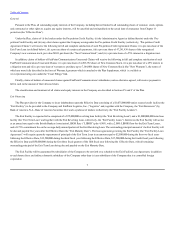FairPoint Communications 2009 Annual Report Download - page 21
Download and view the complete annual report
Please find page 21 of the 2009 FairPoint Communications annual report below. You can navigate through the pages in the report by either clicking on the pages listed below, or by using the keyword search tool below to find specific information within the annual report.
Table of Contents
We are a leading provider of communications services in rural and small urban communities, offering an array of services, including local and long
distance voice, data, Internet, television and broadband product offerings. We operate in 18 states with 1.6 million access line equivalents (including
voice access lines and high speed data lines, which include digital subscriber lines ("DSL"), wireless broadband, cable modem and fiber-to-the-
premises) in service as of December 31, 2009.
We were incorporated in Delaware in February 1991 for the purpose of acquiring and operating incumbent telephone companies in rural and small
urban markets. Many of our telephone companies have served their respective communities for over 75 years.
As our primary source of revenues, access lines are an important element of our business. Over the past several years, communications companies,
including FairPoint, have experienced a decline in access lines due to increased competition, including competition from wireless carriers and cable
television operators, the introduction of DSL services (resulting in customers substituting DSL for a second line) and challenging economic conditions.
In addition, while we were operating under the Transition Services Agreement, we had limited ability to change current product offerings. Upon
completion of the Cutover from the Verizon systems to the new FairPoint systems, we expected to be able to modify bundles and prices to be more
competitive in the marketplace. However, due to certain systems functionality issues (as described herein), we have had limited ability during 2009 to
make changes to our product offerings. In late June 2009, we began actively marketing and promoting our DSL product for the first time since the
Cutover.
We are subject to regulation primarily by federal and state governmental agencies. At the federal level, the FCC generally exercises jurisdiction
over the facilities and services of communications common carriers, such as FairPoint, to the extent those facilities are used to provide, originate or
terminate interstate or international communications. State regulatory commissions generally exercise jurisdiction over common carriers' facilities and
services to the extent those facilities are used to provide, originate or terminate intrastate communications. In addition, pursuant to the
Telecommunications Act of 1996 (the "1996 Act"), which amended the Communications Act of 1934 (the "Communications Act"), state and federal
regulators share responsibility for implementing and enforcing the domestic pro-competitive policies introduced by that legislation.
Legacy FairPoint's operations and our Northern New England operations operate under different regulatory regimes in certain respects. For
example, concerning interstate access, all of the pre-Merger regulated interstate services of FairPoint were regulated under a rate-of-return model, while
all of the rate-regulated interstate services provided by the Verizon Northern New England business were regulated under a price cap model. On
May 10, 2010, we received FCC approval to convert our Legacy FairPoint operations in Maine and Vermont to the price cap model. Our Legacy
FairPoint operations in Maine and Vermont will convert to price cap regulation on July 1, 2010. We have obtained permission to continue to operate our
existing Legacy FairPoint ILECs outside of Maine and Vermont under the rate-of-return regime until the FCC completes its general review of whether
to modify or eliminate the "all-or-nothing" rule. Without this permission, the all-or-nothing rule would require that all of our regulated operations be
operated under the price cap model for federal regulatory purposes. In addition, while all of our operations generally are subject to obligations that apply
to all LECs, our non-rural operations are subject to additional requirements concerning interconnection, non-discriminatory network access for
competitive communications providers and other matters, subject to substantial oversight by state regulatory commissions. In addition, the FCC has
ruled that our Northern New England operations must comply with the regulations applicable to the Bell Operating Companies. Our rural and non-rural
operations are also subject to different regimes concerning universal service.
17
























